Uncategorized
 Lagos State Takes Bold Step: Bans Styrofoam and Single-Use Plastics to Promote Environmental Sustainability
Lagos State Takes Bold Step: Bans Styrofoam and Single-Use Plastics to Promote Environmental Sustainability
The Lagos State Government has implemented a ban on the distribution and use of polystyrene (Styrofoam) and other single-use plastics within its jurisdiction. This commendable decision takes into account the detrimental impact of polystyrene on the environment. To truly enhance liveability, health, and the overall environment in the state, it is crucial for the Babajide Sanwo-Olu administration to rigorously enforce this ban.
It is imperative that other states, the Federal Government, and the Federal Capital Territory swiftly follow Lagos’s example. The Commissioner for the Environment and Water Resources, Tokunbo Wahab, has boldly addressed climate change concerns by emphasizing that the campaign against environmental vandalism will commence with the prohibition of polystyrene (commonly known as Styrofoam), microbeads, carrier bags, plastic spoons, straws, and disposable cups due to their lack of recyclable potential.
The current situation in Lagos is challenging, with poor hygiene behaviors and indiscriminate waste disposal habits among residents. Reports indicate that Lagos generates 870,000 tonnes of plastic, incurring an annual cost of N7 billion for waste management. Used plastics are unsightly, littering roads, gutters, and estates. Drainage networks often become clogged due to the careless disposal of non-biodegradable items, and despite the efforts of the Lagos State Waste Management Authority, roads and markets remain cluttered.
One concern, however, is the lack of adequate notice before the ban, which is typically considered best global practice when implementing significant policies that affect businesses.
The environmental impact of plastics is daunting, with approximately 400 million tonnes of plastic waste generated globally each year, and 36 percent of that being single-use plastics. Furthermore, 96 percent of single-use plastics are produced from fossil fuels. Polystyrene and plastic bags take 500 years to decompose, contributing to the pollution of oceans and endangering marine life. The health risks associated with polystyrene, containing toxic petrochemical compounds like benzene and styrene, are significant, affecting both humans and the ecosystem.
In the face of the devastating effects of climate change, the world is increasingly prioritizing environmental sustainability. Nigeria must not lag behind in safeguarding its ecology. As of 2021, Nigeria joined the top 10 countries releasing the most plastic waste into the ocean, and the World Bank predicts that Nigeria might become the largest plastic waste producer by 2025.
Nigerians must adopt habits that protect the environment, and local, state, and federal governments should actively raise awareness and incentivize environmentally friendly practices. Taking inspiration from countries like Taiwan, Kenya, Rwanda, and Canada, Nigeria has the opportunity to explore local, natural, and healthy alternatives to polystyrene and single-use plastics in food packaging. Viable alternatives such as paper, leaves, cans, bio-plastics, and glass bottles should be considered.
To achieve a sustainable environment and alleviate the strain on the climate, it is essential for the state, local, and federal governments to involve citizens in the enforcement of the plastic ban.
- 26 Jan, 24
- by Admin
- in Uncategorized
-
 0
0
-

 0
0
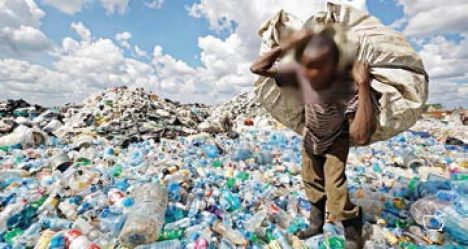 LAGOS BATTLES PLASTIC POLLUTION AMID $2BN RECYCLING INDUSTRY
LAGOS BATTLES PLASTIC POLLUTION AMID $2BN RECYCLING INDUSTRY
Industry players have estimated Nigeria’s recycling industry to be worth at least $2bn. Despite this potential economic opportunity, Lagos State has continued to battle the menace of plastic pollution, writes EDIDIONG IKPOTO
In an exclusive chat with The PUNCH, an environmental expert and President of the Lagos Recyclers Association, Femi Idowu-Adegoke, said the menace of plastic pollution that has perennially plagued Lagos State has been largely down to lack of willingness on the part of residents to adopt recommended waste disposal means that have been prescribed by the relevant authorities.
According to him, Nigeria’s recycling industry has been estimated to be worth a staggering $2bn but has struggled to live up to this lofty estimation due to the menace of indiscriminate disposal of waste and poor orientation of Lagos residents on how to work with professionals to convert this liability to a viable economic opportunity.
More details at:
https://punchng.com/lagos-battles-plastic-pollution-amid-2bn-recycling-industry
- 16 Jun, 23
- by Admin
- in Uncategorized
-
 0
0
-

 0
0
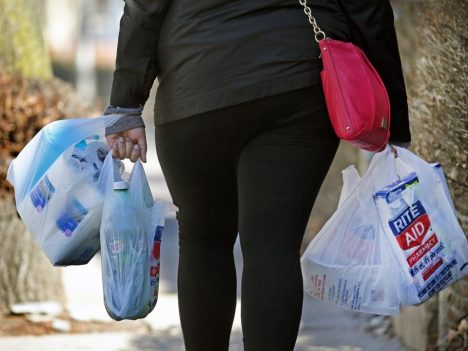 Plastic waste is hurting women in developing countries – but there are ways to stop it
Plastic waste is hurting women in developing countries – but there are ways to stop it
If we are to build a greener, fairer and more equal society in the wake of COVID-19, it’s time for rich countries to end their practice of dumping plastic waste in developing countries. This not only harms the environment but disproportionately affects the women and girls who tend to clear it up.
The problem was made worse for many developing countries when China announced its refusal to accept other countries’ plastic waste in 2018. The result has been an increase in plastic waste exports to Africa, much of which is proving hard to recycle and is ending up in rivers and oceans.
On top of this, the pandemic is generating ever-increasing amounts of plastic waste, especially single-use items like medical gloves and disposable masks. In some areas of Africa – where around 411 million face masks are discarded every day – lack of plastic waste management infrastructure and weak regulations around dumping waste mean the situation is only getting worse.
Now, countries like Ghana, Uganda, Tanzania, Ethiopia, Senegal and Kenya are finding themselves flooded with plastic waste. This is overwhelmingly affecting poor, socially marginalised people, and women in particular.
Unfair trade
Although plastic waste can be seen as a trade between developed and developing countries, which allows the latter to be paid in exchange for dealing with that waste, this trade isn’t an equal one.
Developing countries are likely to accept plastic waste from developed countries because it offers another potential source of income for their population living below the poverty line. It’s projected that 27 million to 40 million people in sub-Saharan Africa will fall into extreme poverty during 2021. It’s no wonder that such regions see plastic waste as a lucrative source of opportunity which can contribute to easing poverty.
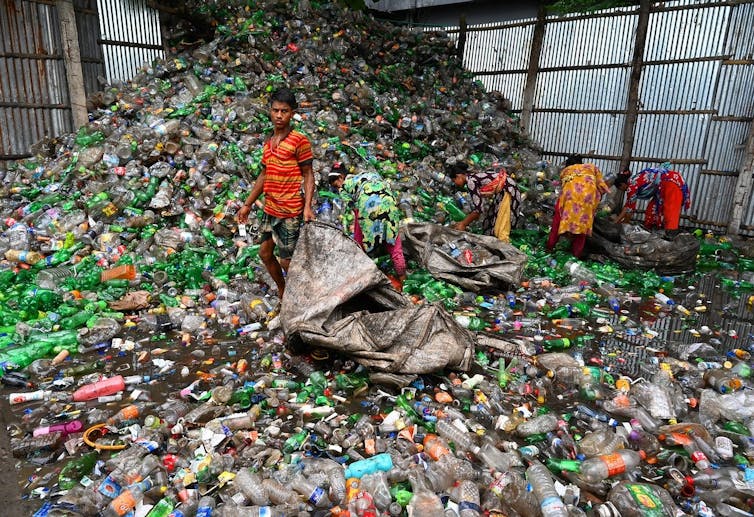
However, the amounts paid to waste pickers – usually women – by private waste collecting companies barely make a dent in pickers’ financial needs. Payments of less than 4 pence a kilogram for collecting plastic bottles for recycling are normal.
And that waste sometimes ends up burned, rather than being recycled. In 2020, 40% of the UK’s plastic waste was sent to Turkey, where instead of being recycled some of it was illegally dumped and burned. Research in 2019 suggested that the equivalent of a double-decker bus full of plastic ends up dumped or burned every second.
Health and security
Many plastics contain toxic chemicals that can enter the environment if products are discarded or burnt. This includes substances that have been linked to miscarriages and cancer.
Picking plastic waste not only doesn’t pay well, it also comes at a price in terms of health and security. Dumped waste can contain hazardous materials like broken glass and syringes carrying infectious illnesses. Plus, women are often forced to collect plastic from the outskirts of cities: places likely to have higher rates of crime.
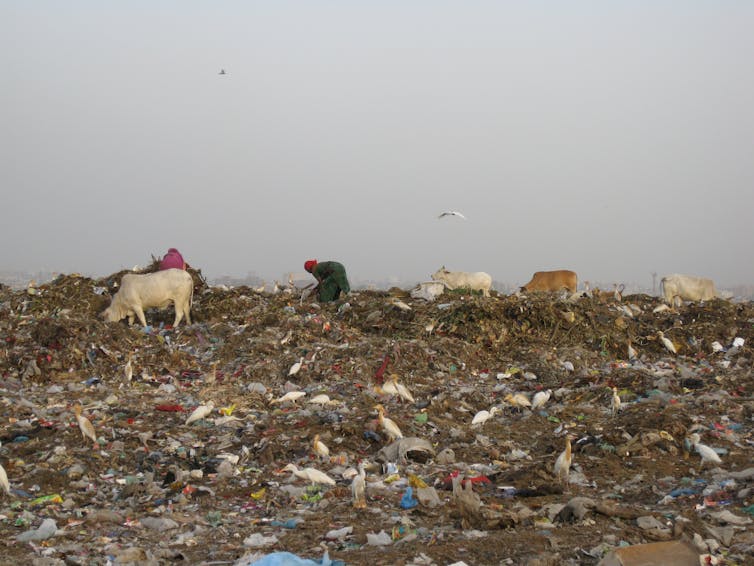
Most, however, don’t have a choice: they must risk their safety to make a living and provide for their families, due to widespread lack of education for women and girls. Across Africa, 3 million more girls than boys between six to 11 years of age will not be offered the opportunity to attend school. The impacts of this ripple into their future, making it far less likely for women to find well-paying jobs and forcing many to resort to low-paid, dangerous work.
Many poorer women in African countries also reside in informal settlements, where waste easily accumulates due to poor rubbish collection services. Accumulating plastic can damage inadequate water drainage systems, resulting in flourishing colonies of dangerous bacteria. For example, Zambia has experienced several cholera outbreaks due to poor drainage worsened in part by plastic-clogged systems.
Justice
It’s imperative to find ways of improving women’s situations in developing countries if we are to realise a truly greener, fairer and more equal world.
Some next steps to consider – if such a world is to become a reality – would include developing countries creating more stringent legislation against dumping plastic, increasing women’s education and involving more women in decision-making processes around how to deal with plastic waste.
What’s more, creating social incentives for reducing plastic waste – for example, by paying pickers more – is key in societies where social status is attached to those who can afford bottled plastic water and removed from those who then must pick up their litter.
Community-based awareness programmes promoting the importance of plastic waste management – run via community clubs, social platforms like Facebook and Instagram, or local radio stations – could help achieve this.
If picking plastic waste became better paid, this kind of cultural shift would not only help to empower women pickers economically but may be able to eliminate stigma attached to picking. With a resulting influx of formalised training courses, policies to keep pickers safe and opportunities for pickers to speak out about the issues attached to their work, many others will hopefully be attracted to help keep their local environments clean and safe.
- 17 Nov, 21
- by Admin
- in Uncategorized
-
 0
0
-

 0
0
 Waste plastic deluge could soon prove irreversible
Waste plastic deluge could soon prove irreversible
The waste plastic deluge fouling the world’s beaches could be more than just an eyesore. It could be a toxic timebomb.
LONDON, 8 July, 2021 − European researchers have warned that the wave of pollution engulfing the globe could be nearing a tipping point. The waste plastic deluge could become an irreversible crisis.
Somewhere between 9 and 23 million tonnes of polymers get into the rivers, lakes and seas of the world every year. Even more may be getting into the terrestrial soils and by 2025 − unless the world changes its ways − these levels of pollution will have doubled.
And, the researchers warn, the uncertain and as yet unknown effects of weathering on such volumes of plastic could bring what has been called “a global toxicity debt” as drinking bottles, bits of fishing gear, coffee cups and carrier bags become covered with microbial life; as plastic particles foul the sea’s surface, become suspended in the water column, and build up in the sediments of the ocean.
Plastic waste has now been found everywhere: on the world’s highest mountains, in the deepest oceanic trenches, on the beaches of desolate islands in the Southern Ocean, in the Arctic ice, and in the tissues of living creatures, from seabirds to whales.
Worsening climate crisis
“Right now we are loading up the environment with increasing amounts of poorly reversible plastic pollution. So far we don’t see widespread evidence of bad consequences but if weathering plastic triggers a really bad effect we are not likely to be able to reverse it,” said Matthew Macleod of Stockholm University in Sweden.
“The cost of ignoring the accumulation of persistent plastic pollution in the environment could be enormous. The rational thing to do is act as quickly as we can to reduce emissions of plastic into the environment.”
Professor Macleod and colleagues warn in the journal Science that alongside threats to wildlife, and the potential hazard of environmental poisoning, there could be a number of other hypothetical consequences.
Plastic pollutants could exacerbate climate change by disrupting the traffic of carbon between the natural world and the atmosphere, and they could heighten biodiversity loss in the already over-fished oceans.
Researchers do not yet know of the long-term non-toxicological effects of plastic pollution on carbon and nutrient cycles, soil and sediment fertility, and biodiversity. Nor has there been any assessment of the potential for delayed toxic effects as the plastic polymers are altered by weathering.
“The rational thing to do is act as quickly as we can to reduce emissions of plastic into the environment”
And if there are such effects, then they could persist, to trigger what the scientists call a “tipping point”, long after people have stopped discarding plastic waste into the environment.
“The world promotes technological solutions for recycling and to remove plastic from the environment. As consumers, we believe that when we properly separate our plastic trash, all of it will magically be recycled,” said Mine Tekman, of the Alfred Wegener Institute in Germany, and a co-author.
“Technologically, recycling of plastic has many limitations, and countries that have good infrastructures have been exporting their plastic waste to countries with worse facilities. Reducing emissions requires drastic actions, like capping the production of virgin plastic to increase the value of recycled plastic, and banning the export of plastic waste unless it is to a country with better recycling.”
And her colleague Annika Jahnke of the Helmholtz Centre for Environmental Research in Germany warned: “In remote environments, plastic debris cannot be removed by cleanups, and weathering of large plastic items will inevitably result in the generation of large numbers of micro- and nano-plastic particles as well as leaching of chemicals that were intentionally added to the plastic and other chemicals that break off the plastic polymer backbone.
“So, plastic in the environment is a constantly moving target of increasing complexity and mobility. Where it accumulates and what effects it may cause are challenging or maybe even impossible to predict.” − Climate News Network
- 22 Jul, 21
- by Admin
- in Uncategorized
-
 0
0
-

 0
0
 Kenyan Engineer Recycles Plastic Into Bricks Stronger Than Concrete
Kenyan Engineer Recycles Plastic Into Bricks Stronger Than Concrete
Nzambi Matee is an entrepreneur with an incredible goal — to turn plastic destined for the landfill into sustainable, strong building material. Her company, Gjenge Makers, uses the plastic waste of commercial facilities to create bricks that can withstand twice the weight threshold of concrete.
Gjenge Makers is based in Nairobi, Kenya, where plastic waste pollution has become a severe problem. A study supported by the National Environmental Management Agency (NEMA) found that more than 50% of cattle near urban areas in Kenya had plastic in their stomachs. To combat this issue, the Kenyan government outlawed the use of plastic bags in 2017, and imposed a ban on all single-use plastic in protected natural areas last year. However, these bans only address the issue of consumer single-use plastic. Commercial waste is still a deep-seated problem within the country.
Nzambi Matee told reporters she was “tired of being on the sidelines,” and decided to create a solution of her own for commercial plastic waste. With a career in materials engineering, she was able to design a brick made of recycled plastic and sand, compressed and heated to create a strong and sustainable alternative to concrete. The fibrous structure of the plastic makes it not only more lightweight but also less brittle than concrete.
“Our product is almost five to seven times stronger than concrete,” Matee told Reuters about the current line of Gjenge Makers pavers and bricks. While she purchases some plastic from recycling companies, she also receives free shipments of plastic waste from local packaging factories. Currently, the Gjenge Makers factory can produce up to 1,500 bricks each day, according to Reuters.
The company offers pavers for residential and commercial uses. The heavy-duty 60 mm paver is strong enough to be used for parking lots and roads, while the 30 mm light-duty paver can be used for household patios and walkways. The light-duty paver is twice the strength of concrete and comes in a variety of colors.
The factory is only in its beginning stages, but it has already recycled 20 tons of plastic since 2017 and created 120 jobs in Nairobi. In addition, Gjenge bricks are also one of the more affordable options on the market. They cost approximately $7.70 per square meter, as opposed to $98 per square yard for concrete produced in the U.S.
However, it hasn’t been an easy road. Matee says about the founding of her company, “I jumped in, off a cliff without even a parachute. I was building it as I was falling down. But isn’t that how great things are done?”
With entrepreneurs like Matee, there is a beacon of hope for the worldwide plastic pollution crisis. To learn more about Gjenge Makers process and impact, you can visit their website or YouTube channel. Or, read this to learn more about ways you can help fight against plastic pollution in your community.
- 09 Mar, 21
- by Admin
- in Uncategorized
-
 0
0
-

 0
0
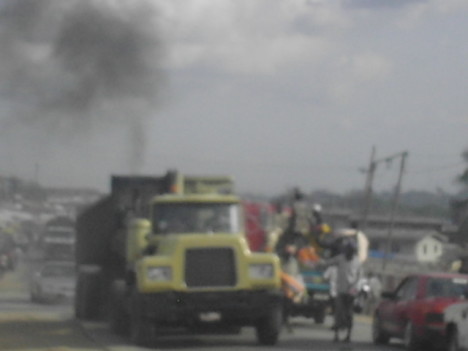 New Jersey Legislature Passes ‘Most Comprehensive’ Plastics Ban in the Nation
New Jersey Legislature Passes ‘Most Comprehensive’ Plastics Ban in the Nation
New Jersey is one step closer to passing what environmental advocates say is the strongest anti-plastic legislation in the nation.
The state Legislature passed a sweeping measure Thursday that would ban plastic bags from stores and restaurants and single-use food and drink containers made from polystyrene foam, The New York Times reported. The ban is noteworthy for being the first in the country to include supermarket paper bags as well as plastic ones.
“This is the single most comprehensive plastics and paper reduction bill in the nation,” former U.S. Environmental Protection Agency (EPA) Regional Administrator and Beyond Plastics President Judith Enck said in a statement published by Insider NJ. “Building on the success of local laws adopted throughout New Jersey to reduce plastic pollution, the NJ State Legislature listened to the people and not the polluters and embraced a sensible environmental strategy.”
The bill now passes to Gov. Philip Murphy, who intends to sign it, a spokesperson told The New York Times. The bans on bags and containers will go into effect 18 months after he does so, NorthJersey.com reported.
In addition to banning plastic and paper bags and plastic food containers, the bill will also limit plastic straws in restaurants so that they will only be available upon request. There are exemptions for newspaper bags; bags used for loose produce, fish or meat; dry-cleaning bags and prescription drug bags.
The measure effectively settles a long-running debate about whether plastic or paper bags are worse for the environment by banning both. Plastic bags account for about 12 percent of U.S. plastic pollution, according to The New York Times. But paper bags need more energy, and therefore more climate pollution, to make. New Jersey Sierra Club Director Jeff Tittle said the new legislation would encourage people to use more sustainable, reusable shopping bags.
However, the ban on paper bags was also the key to getting an important supermarket trade group to support the bill, NorthJersey.com reported. The organization argued that it would cost stores too much to supply customers with only paper bags.
“The ban on paper bags is critically important to the success of this legislation,” New Jersey Food Council President Linda Doherty said ahead of Thursday’s vote. “Without a ban, consumers will simply move to paper single-use bags and we will not address the underlying goal of reducing our reliance on single-use products.”
However, the food council originally opposed any sort of statewide bag ban, NJ Spotlight News reported. It changed its position after as many as 57 communities passed their own separate bans and it decided it would be easier to deal with a single, statewide law than a patchwork of local ones.
Not everyone has been persuaded, however. American Forest and Paper Association President and Chief Executive Heidi Brock said the bill unfairly targeted her industry.
“The New Jersey Legislature has undermined an environmentally responsible option for consumers,” she said in a statement reported by The New York Times. “Furthermore, the ban on paper bags sends an alarming message in devaluing family wage jobs, which are often union labor, in addition to the indirect jobs supported by the paper and wood products industry in the state.”
Republican Assemblywoman Holly Schepisi, meanwhile, argued that the bill would put an additional burden on a restaurant industry already struggling because of the coronavirus pandemic.
“We’re essentially kicking them in the head,” she said, as NJ Spotlight News reported.
On the other hand, environmental advocates argued that plastic has long polluted New Jersey waterways. In recent years, more than 80 percent of the litter gathered on beaches by Clean Ocean Action from Cape May to Sandy Hook has been plastic, NorthJersey.com reported. The material has even been found in some of the state’s most pristine rivers and creeks.
“Now, we can all look forward to picking up less trash on our beaches,” Clean Ocean Action executive director Cindy Zipf told NorthJersey.com. “There will be less plastics in the ocean to cause harm and death to marine life.”
- 29 Sep, 20
- by Admin
- in Uncategorized
-
 0
0
-

 0
0
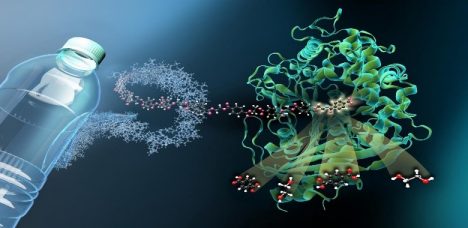 Scientists Find Bacteria That Eats Plastic
Scientists Find Bacteria That Eats Plastic
German researchers have identified a strain of bacterium that not only breaks down toxic plastic, but also uses it as food to fuel the process, according to The Guardian

The scientists discovered the strain of bacteria, known as pseudomonas bacteria, at a dump site loaded with plastic waste , where they noticed that it was attacking polyurethane. Polyurethane’s are ubiquitous in plastic products because they are pliable and durable. However, when they reach the end of their usefulness and end up in landfills, they decompose slowly and slowly release toxic chemicals into the soil as they degrade. They are also notoriously difficult to recycle, according to Courthouse News.
Since it is so difficult to recycle, millions and millions of products containing polyurethane like sneakers, diapers, kitchen sponges and foam installation end up in landfills. Polyurethane usually kills most bacteria too, so it surprised the researchers to find a strain that not only survived, but also used polyurethane to thrive, according to The Guardian. The findings were published in the journal Frontiers in Microbiology.
“The bacteria can use these compounds as a sole source of carbon, nitrogen and energy,” Hermann J. Heipieper, a senior scientist at the Helmholtz Centre for Environmental Research-UFZ in Leipzig, Germany and co-author of the new paper, said in a statement. “These findings represent an important step in being able to reuse hard-to-recycle polyurethane products.”
Pseudomonas bacteria are part of a family of microorganisms known for its ability to withstand harsh conditions, such as high temperatures and acidic environments.
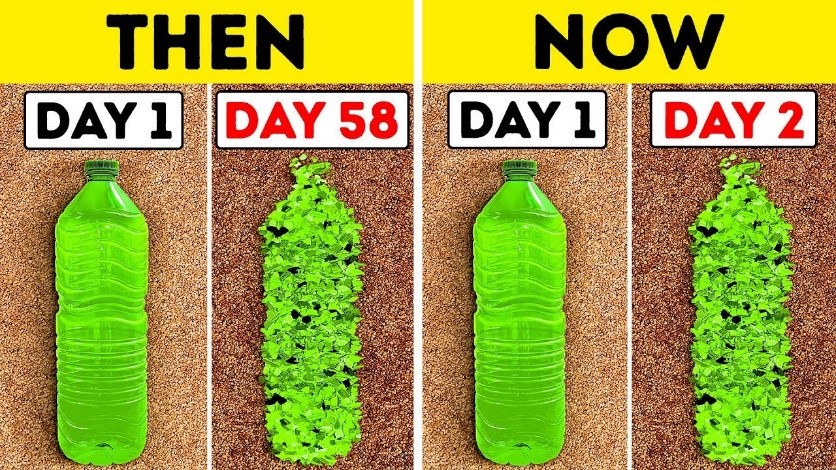
While the little germs offer hope for a solution to the plastic crisis polluting land and water around the globe, scientists are still a long way away from being able to use the bacteria on a large scale. Heipieper estimated that it could be 10 years before the bacteria are ready to consume plastic at a large scale. He added that in the meantime, it is important to reduce the use of non-recyclable plastic and to cut the amount of plastic used around the world, according to The Guardian.
Our reliance on plastic has created a waste crisis. In 2015, polyurethane products alone accounted for 3.5 million tons of the plastics produced in Europe, according to a press release from the journal that published the study. More than 8 billion metric tons of plastic has been produced since the 1950s, according to The Guardian, and a vast majority of it has polluted the world’s land and oceans, or ends up in landfills. Scientists say it threatens a “near permanent contamination of the natural environment.”
As for polyurethane, its heat resistance make it a difficult and energy intensive to melt down. Because of that, it is disproportionately tossed into landfills around the world where its slow degradation releases toxic — and often carcinogenic — chemicals, according to Courthouse News.
In the laboratory, the researchers fed key components of polyurethane to the bugs. “We found the bacteria can use these compounds as a sole source of carbon, nitrogen and energy,” Heipieper said, as The Guardian reported.

“When you have huge amounts of plastic in the environment, that means there is a lot of carbon and there will be evolution to use this as food,” Heipieper said as The Guardian reported.
“Bacteria are there in huge numbers and their evolution is very fast. However, this certainly doesn’t mean that the work of microbiologists can lead to a complete solution,” he added. “The main message should be to avoid plastic being released into the environment in the first place.”
- 06 Apr, 20
- by Admin
- in Uncategorized, Youth Awareness
-
 0
0
-

 0
0
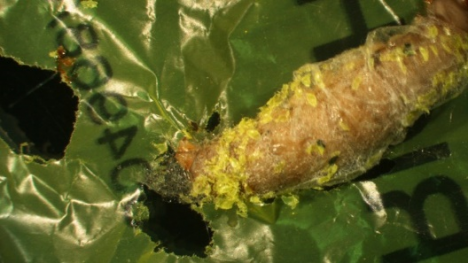 How a Plastic-Eating Caterpillar Could Help Solve the World’s Waste Crisis
How a Plastic-Eating Caterpillar Could Help Solve the World’s Waste Crisis
Scientists are learning more about a caterpillar that is very hungry for plastics!
The plastic-munching abilities of the greater wax moth caterpillar were first discovered in 2017 when a scientist and amateur beekeeper put some of the insects, who also eat beeswax, into a plastic bag only to discover that they had eaten their way out. Now, researchers at the University of Brandon have discovered that the larval greater wax moths can survive solely on polyethylene — the type of plastic that makes grocery shopping bags.
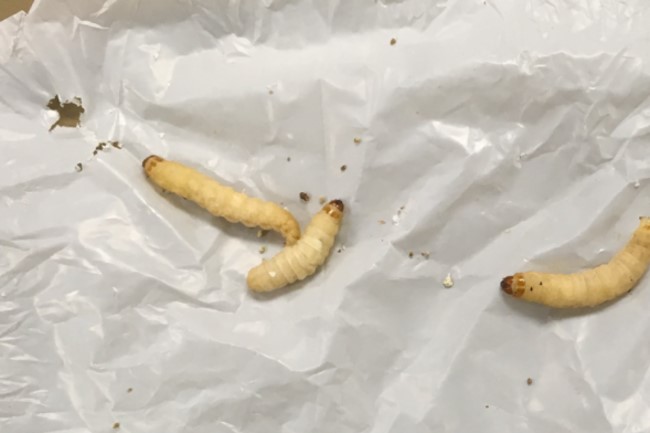
“They are voracious feeders during these larval stages,” lead study author and Brandon University associate biology professor Bryan Cassone told USA today
- 06 Apr, 20
- by Admin
- in Uncategorized, Youth Awareness
-
 0
0
-

 0
0
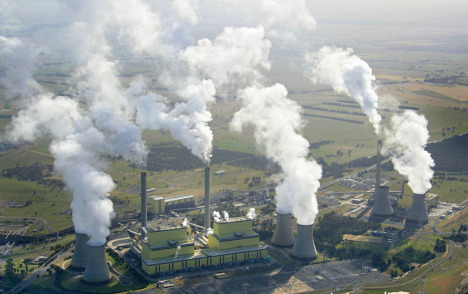 Plastic warms the planet twice as much as aviation – here’s how to make it climate-friendly
Plastic warms the planet twice as much as aviation – here’s how to make it climate-friendly
We’re all too aware of the consequences of plastics in the oceans and on land. However, beyond the visible pollution of our once pristine habitats, plastics are having a grave impact on the climate too.
Newly published research calculates that across their lifecycle, plastics account for 3.8% of global greenhouse gas emissions. That’s almost double the emissions of the aviation sector. If it were a country, the “Plastic Kingdom” would be the fifth-highest emitter in the world.
Demand is set to rise, too. At 380m tonnes a year, we produce 190 times more plastic than we did in 1950. If the demand for plastic continues to grow at its current rate of 4% a year, emissions from plastic production will reach 15% of global emissions by 2050.
Plastic across the lifecycle
More than 99% of plastics are manufactured from petrochemicals, most commonly from petroleum and natural gas. These raw materials are refined to form ethylene, propylene, butene, and other basic plastic building blocks, before being transported to manufacturers.
The production and transport of these resins requires an awful lot of energy – and therefore fuel. Greenhouse gas emissions also occur during the refining process itself – the “cracking” of larger hydrocarbons from petrochemicals into smaller ones suitable for making plastic releases carbon dioxide and methane. According to the study, about 61% of total plastic greenhouse gas emissions comes from the resin production and transport stage.
A further 30% is emitted at the product manufacturing stage. The vast majority of these emissions come from the energy required to power the plants that turn raw plastic materials into the bottles, bin bags and bicycle helmets we use today. The remainder occurs as a result of chemical and manufacturing processes – for example, the production of plastic foams uses HFCs, particularly potent greenhouse gases.

Ignition of trapped methane pockets in landfills can set off massive fires, releasing the carbon stored in plastic.
The remaining carbon footprint occurs when plastics are thrown away. Incineration releases all of the stored carbon in the plastic into the atmosphere, as well as air pollutants such as dioxins, furans, mercury and polychlorinated biphenyls, which are toxic and damaging to human health.
As plastics take centuries to degrade, disposal in landfill makes only a small contribution to emissions in theory. However, as much as 40% of landfill waste is burnt in open skies, dramatically speeding up the release of otherwise locked-up carbon.
Making plastic climate-friendly
If we are to combat climate breakdown, reductions in plastic emissions are clearly needed. Thankfully, the solution with the biggest potential is already in motion, albeit snow. In showing that transitioning to a zero carbon energy system has the potential to reduce emissions from plastic by 51%, the study provides yet another reason to rapidly phase out fossil fuels.
However, beyond urgently required global decarbonisation, we need to reduce our seemingly insatiable demand for carbon-based plastic. Increasing recycling rates is one simple way of doing this. The highest-quality plastics can be recycled many times, and nearly all plastic can be recycled to some extent – but only 18% was actually recycled worldwide in 2015. Although each recycle process requires a small amount of new plastics, we can greatly increase the life cycle of the material by efficiently reusing what we make.
A more fundamental solution is to switch to making plastics from biodegradable sources such as wood, corn starch, and sugar cane. The materials themselves are carbon neutral, although renewable power is essential to eliminate the climate impact of energy costs during production, transport and waste processing.
However, a massive ramping up in the production of bioplastics – which currently make up less than 1% of total plastic production – would require vast swathes of agricultural land. With the population set to arise dramatically, increasingly coveted arable space may not be able to satisfy demand.

The bottom line, therefore, is that we will need to reduce our demand for plastic. According to the study, simply reducing the annual growth in plastics demand from 4% to 2% could result in 60% lower emissions from the sector in 2050. While a life without plastics may seem unimaginable, its worth remembering that their prevalence is a relativity recent phenomenon. The first artificial plastic, Bakelite, was developed in 1907, but it wasn’t until the 1950s that the age of plastic began. If we show a genuine appetite to address plastic pollution, the world could change again just as quickly.
Governments, corporations, and individuals must make research into alternatives a priority, and support alternatives to needless plastic waste. Were most people to carry a reusable water bottle, for example, we could eliminate the need for the estimated 20,000 single-use bottles bought each second around the world.
Of course, any of these solutions alone will not be enough. As the recent study notes, only by combining reduction in demand, top-notch recycling, decarbonisation of energy, and large-scale adoption of bioplastics can we tackle plastic’s contribution to the climate crisis. But if we manage to do all of this, then we can cut plastics emissions to just 7% of current levels.
Plastics need not be completely demonised as environmental scourges. Affordable, durable, and versatile, they bring a raft of societal beefits, and will undoubtedly serve an important role where replacements are unable to be found. But decades of unbridled use and a throw-away culture are having grave consequences that go far beyond the visible pollution of our land and water. It is essential that we drastically reduce our use of avoidable plastics, and eliminate the carbon footprint of the ones we need to use. Our relationship with plastic may be toxic, but it doesn’t need to be forever.
- 20 Mar, 20
- by Admin
- in Climate Change, Uncategorized
-
 0
0
-

 0
0
